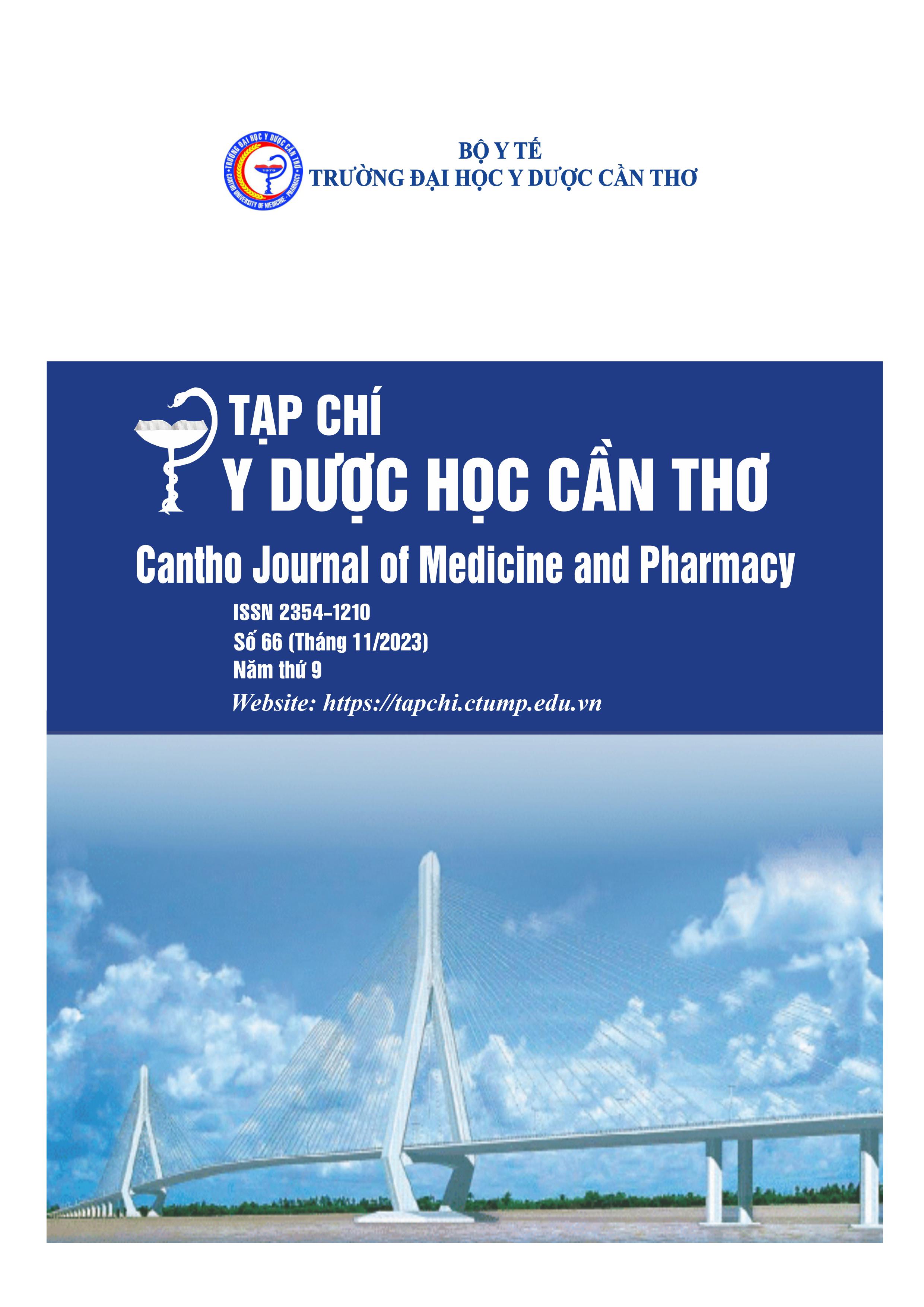EVALUATION OF THE RESULTS OF BRADYARRHYTHMIAS TREATMENT WITH PERMANENT PACEMAKER IMPLANTATION
Main Article Content
Abstract
Background: Permanent pacemaker implantation is an effective treatment for bradyarrhythmias when the cause is irreversible. Objectives: To evaluate the outcomes of bradyarrhythmias treatment with permanent pacemaker implantation. Materials and methods: A randomized clinical intervention study on 55 patients with bradyarrhythmias were implanted permanent pacemakers at Can Tho Central General Hospital in 2022-2023. Results: In 40 patients with sinus node dysfunction and 15 patients with atrioventricular block who received permanent pacemaker implantation, 100% of the cases were accessed to the vein by axillary vein, and 100% of the ventricular lead positions were placed in the right ventricular septum, 87.3% of patients were implanted with a permanent dual-chamber pacemaker. The technical success rate was 100%, and the clinical success rate after 3 months was 85.5%. Patients with permanent 2-chamber pacemaker implantation had a statistically significant improvement in left ventricular ejection fraction as well as a decrease in systolic pulmonary artery pressure after 3 months compared with before implantation (p<0.001). Conclusion: Permanent pacemaker implantation effectively treats bradyarrhythmias with high technical and clinical success and minimum complication.
Article Details
Keywords
bradyarrhythmia, permanent pacemaker, dual-chamber pacemaker
References
2. Sidhu S., Marine J.E. Evaluating and managing bradycardia. Trends Cardiovasc Med. 2020. 30(5), 265-272, https://doi.org/10.1016/j.tcm.2019.07.001.
3. Kusumoto F.M and GoldSchager N. Pace-makers: type, function, and indications. Seminars in Cardiothoracic and Vascular Anesthesia. 2000. 4(3), 122-137, doi: 10.1053/scva.2000.84
4. Cano Ó., Andrés A., Alonso P., Osca J., Sancho-Tello M.J. et al. Incidence and predictors of clinically relevant cardiac perforation associated with systematic implantation of active-fixation pacing and defibrillation leads: a single-centre experience with over 3800 implanted leads. Europace. 2017. 19(1), 96-102, doi: 10.1093/europace/euv410.
5. Kenneth A.E., Bruce L.W., Kay N.G., Lau C.P. Clinical cardiac pacing, defibrillation, and resynchronization therapy. Elsevier. 2017. 500-808.
6. Glikson M., Nielsen J.C., Kronborg M.B., Michowitz Y., Auricchio A., et al. 2021 ESC Guidelines on cardiac pacing and cardiac resynchronization therapy: Developed by the Task Force on cardiac pacing and cardiac resynchronization therapy of the European Society of Cardiology (ESC) With the special contribution of the European Heart Rhythm Association (EHRA). Rev Esp Cardiol. 2021. 42(35), 3427-3520, doi: 10.1093/eurheartj/ehab364.
7. Huỳnh Van Minh̆ , Hoàng Anh Tiến, Đoàn Khánh Hùng, Nguyễn Vũ Phòng, Ngô Viết Lâm và cộng sự. Nghiên cứu áp dụng tạo nhịp tim vĩnh viễn và tối ưu hóa lập trình tại bệnh viện Đại học Y Dược Huế. Tạp chí Y Dược học. 2018. 8(3), 114-121, doi: 10.34071/jmp.2018.3.18.
8. Kerola T., Eranti A., Aro A.L., Haukilahti M. A., Holkeri A. et al. Risk Factors Associated With
Atrioventricular Block. JAMA Netw Open. 2019. 2(5), 1-13, doi: 10.1001/jamanetworkopen.2019.4176.
9. Bạch Thị Hoa, Phạm Như Hùng và Nguyễn Thị Phương Thảo. Đánh giá chất lượng cuộc sống của người bệnh rối loạn nhịp chậm sau cấy máy tạo nhịp vĩnh viễn. Tạp chí Y học Việt Nam. 2021. 507(1), 86-90, doi: 10.51298/vmj.v507i1.1327.
10. Tjong F.V.Y., de Ruijter U.W., Beurskens N.E.G., Knops R.E. A comprehensive scoping review on transvenous temporary pacing therapy. Neth Heart J. 2019. 27(10), 462-473, doi:
10.1007/s12471-019-01307-x.
11. Polyzos K. A., Konstantelias A.A., Falagas M.E. Risk factors for cardiac implantable electronic device infection: a systematic review and meta-analysis. Europace. 2015. 17(5), 767-77, doi: 10.1093/europace/euv053.
12. Liu P., Zhou Y.F., Yang P., Gao Y.S., Zhao G.R., et al. Optimized Axillary Vein Technique versus Subclavian Vein Technique in Cardiovascular Implantable Electronic Device Implantation: A Randomized Controlled Study. Chin Med J (Engl). 2016. 129(22), 2647-2651, doi: 10.4103/0366-6999.193462.
13. Burri H., Starck C., Auricchio A., Biffi M., Burri M., et al. EHRA expert consensus statement and practical guide on optimal implantation technique for conventional pacemakers and implantable cardioverter-defibrillators: endorsed by the Heart Rhythm Society (HRS), the Asia Pacific Heart Rhythm Society (APHRS), and the Latin-American Heart Rhythm Society (LAHRS). Europace. 2021. 23(7), 983-1008, doi: 10.1093/europace/euaa367.
14. Lamas G.A., Lee K.L., Sweeney M.O., Silverman R., Leon A., et al. Ventricular pacing or dualchamber pacing for sinus-node dysfunction. N Engl J Med. 2002. 346(24), 1854-62, doi: 10.1056/NEJMoa013040.
15. Đoàn Chí Thắng, Ngô Lâm Sơn, Mai Xuân Anh. Nghiên cứu đặc điểm lâm sàng, cận lâm sàng ở bệnh nhân trước và sau đặt máy tạo nhịp tim vĩnh viễn hai buồng tại Bệnh viện Trung ương Huế. Tạp chí Tim mạch học Việt Nam. 2021. 98, 74-82, doi: 10.58354/jvc.98.2021.97.


